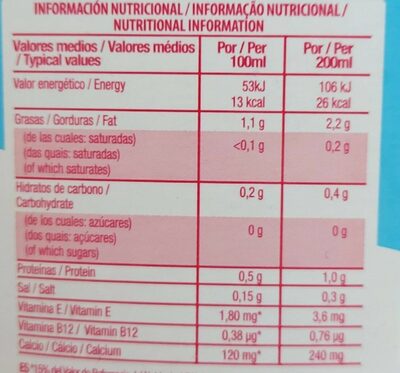Almond breeze - Blue Diamond - 1 l
Aquesta pàgina del producte no està completa. Podeu ajudar a completar-la editant-la i afegint-hi més dades a partir de les fotos ja disponibles, o fent-ne més amb l'aplicació de androide o iPhone / iPad. Gràcies!
×
Codi de barres: 0041570112731 (EAN / EAN-13) 041570112731 (UPC / UPC-A)
Nom comú: Bebida de almendras UHT con calcio y vitaminas
Quantitat: 1 l
Empaquetament: en:multilayer-composite, Tetra Pak, Tetra Brik, es:Ultrapasteurizado
Marques: Blue Diamond, Feiraco
Categories: Aliments i begudes amb base vegetal, Begudes, Aliments amb base vegetal, en:Dairy substitutes, Substitutius de la llet, Fruits secs i derivats, Begudes amb base vegetal, Begudes vegetals, Beguda de fruits secs, Beguda d'ametlla
Etiquetes, certificacions, premis:
Lliure de gluten, Vegetarià, Vegà, 100% vegetal, Font de calci, FSC, Mix FSC, Sense sucre afegit, Sense ou, Sense lactosa, Sense llet, Lliure de soja, Font de vitamina B12, Font de Vitamina D, Font de vitamina E, es:Bajo en grasas saturadas
Origen dels ingredients: Estats Units d'Amèrica, Califòrnia, es:[ALMENDRAS]
Llocs de fabricació o processament: Agrón (parroquia), Ames, La Coruña (provincia), Galicia, España
Codi de traçabilitat: NIF: B-15996929, FEIRACO LÁCTEOS S.L., BLUE DIAMOND GROWERS CORPORATION
Enllaç a la pàgina del producte en el lloc oficial del productor: http://almondbreeze.es/producto/bebida-a...
Botigues: Carrefour, El Corte Inglés, Hipercor, Eroski
Països on es va vendre: Espanya
Matching with your preferences
Entorn
Petjada de carboni
Empaquetament
Transport
Report a problem
Fonts de dades
Producte afegit per javichu
Última modificació de la pàgina del producte per tasja.
La pàgina del producte, també editada per 5m4u9, kiliweb, neptuno, openfoodfacts-contributors, thaialagata, worldtest, yuka.L59BPdCMAOs9Avfo9JwMwAK6G92wI9RBNEdXow, yuka.V0pvdEVQZ3NtOWhUaHNBaTJUM3Q0b01vMVlXM1oxaUpPdTBXSVE9PQ, yuka.VupCF-yRDpEDBfb0w4w_1miyC8XqHNlrSW8ToQ, yuka.WEpzYU0vVXptYUFseFBRUnBobnk2dlJzeUxHWGYyK1ZJc1ZBSVE9PQ, yuka.WVpBUE1QMGk5dWtrdGR0am95cmw0SWhmeXB1SFkwNjRKZGNlSWc9PQ, yuka.WklRYUhQVURpZFlIbDlvMHp3cmI2OEJyeTdYM2IzS3FLZlVwSVE9PQ, yuka.sY2b0xO6T85zoF3NwEKvllxcCN7CrQLEbB_Sgn2i_eWkDrfNRYpqzJHmMqg.










